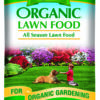When it comes to creating a beautiful and sustainable garden, it’s crucial to consider not just the aesthetics, but also the safety of our furry friends and the resilience of the plants we choose. For those of us living in the sunny state of California, this often means selecting foliage that can stand up to the heat and go easy on water consumption.
Key Takeaways
- Native plants are not only beautiful but also offer a safe environment for pets and local wildlife.
- Choosing drought-tolerant plants helps conserve water and ensures your garden thrives in California’s hot climate.
- Salvia species, also known as sages, are excellent choices for pet-safe, drought-resistant gardens.
- Manzanita varieties provide vibrant color and are robust enough to withstand dry conditions.
- It’s important to recognize common backyard plants that could be toxic to pets and find safe alternatives.

“California buckwheat (Eriogonum …” from www.picturethisai.com and used with no modifications.
Garden Green: How to Choose Pet-Safe and Resilient Plants
Creating a garden that’s both pet-safe and drought-resistant starts with selecting the right plants. Native plants are typically well-adapted to the local climate and soil conditions, which makes them more resilient and easier to maintain. Plus, they’re less likely to harm curious pets who might nibble on them.
Spotlight on California Native Plants
California’s diverse ecosystems are home to a wide variety of native plants that have evolved to thrive in the local conditions. These plants are naturally adapted to the state’s climate, making them particularly drought-tolerant. By incorporating these natives into your garden, you’re choosing a landscape that requires less water and maintenance, which is a win for both the environment and your free time.
But it’s not just about saving water. Native plants offer a safe haven for pets. They’re less likely to contain harmful toxins that can sicken curious critters. That’s because they’ve grown alongside local wildlife for centuries, forming a balanced ecosystem that supports all types of life.
Meeting Drought and Heat Challenges
In the face of rising temperatures and prolonged dry spells, it’s more important than ever to choose plants that can withstand these conditions. Drought-tolerant plants have special adaptations that allow them to survive with minimal water. These adaptations often include deep root systems, waxy or hairy leaves that reduce water loss, and the ability to go dormant during particularly dry times.
By choosing these resilient species, you’ll ensure your garden remains a lush oasis even when the weather doesn’t cooperate. And, you’ll be doing your part to conserve water – a precious resource in our sunny state.
The Hummingbird’s Friend: Salvia Species
Among the shining stars of a pet-safe, drought-resistant garden are the Salvia species, commonly known as sages. These delightful plants are not only adored by hummingbirds but are also a fantastic choice for pet owners. With their aromatic leaves and vibrant flowers, they add a splash of color and fragrance to any garden.
Most importantly, Salvias are non-toxic to dogs and cats. This means you can plant them without fear that an accidental nibble will lead to an emergency vet visit. Because they’re native to California, they’re accustomed to thriving in dry conditions with minimal water. Their hardiness makes them an excellent choice for gardeners looking to reduce their water usage.
The Sturdy and Vibrant: Manzanita Varieties
Manzanita, with its distinctive red bark and delicate pink or white flowers, is another excellent addition to your pet-friendly garden. These hardy shrubs are known for their ability to withstand drought and even poor soil conditions. Their thick leaves help retain moisture, ensuring the plant stays hydrated even when water is scarce.
Furthermore, Manzanitas are safe for pets, which means your furry companions can explore the garden without risk. Their dense foliage also provides shelter for birds and beneficial insects, making your garden a haven for local wildlife as well as a serene spot for you and your pets to enjoy.
Heat-Tolerant Gems for a Scorching Summer
When the heat is on, some plants shrivel while others shine. Heat-tolerant plants like the California Fuchsia (Epilobium canum) and the Coast Sunflower (Encelia californica) are perfect for keeping your garden vibrant during the scorching summer months. These plants not only withstand high temperatures but also add a pop of color to your landscape.
Designing Your Drought-Resistant, Pet-Friendly Garden
Designing a garden that’s both drought-resistant and pet-friendly requires careful planning. Start by mapping out your space, considering both the sun and shade patterns throughout the day. This will help you determine the best locations for each plant, ensuring they get the right amount of light to thrive.
Choosing the Right Spot for Each Plant
When it comes to placing your plants, keep in mind that not all spots in your garden are created equal. Some areas might be naturally damper or shadier, which could be perfect for plants that need a bit more moisture. Others might be sun-soaked and dry, ideal for those drought-tolerant species.
For example, the charming California Poppy (Eschscholzia californica) thrives in full sun and well-drained soil, making it a perfect candidate for those sunnier spots. On the other hand, Western Sword Ferns (Polystichum munitum) prefer a bit of shade and can handle slightly wetter conditions.
Therefore, it’s not just about the plants you choose, but also where you plant them. A well-thought-out garden design ensures that each plant’s needs are met, reducing the need for extra watering or maintenance.
- Identify the sunniest and shadiest parts of your garden.
- Group plants with similar water and light requirements together.
- Consider the mature size of plants to avoid overcrowding.
- Use a quality mulch to help retain soil moisture and reduce watering needs.
Besides that, remember to give your plants room to grow. Overcrowding can lead to competition for resources and increase the likelihood of disease.
Maintaining a Lush Look with Minimal Watering
To maintain a lush garden with minimal watering, mulching is key. A thick layer of mulch helps to keep the soil cool and moist, reducing the rate of evaporation. Organic mulches, such as wood chips or straw, not only conserve water but also break down over time, enriching the soil with nutrients.
Plants to Avoid: Keeping Furry Friends Safe
While many plants are safe for pets, some common garden choices can be dangerous. It’s essential to be aware of these and either avoid them or ensure they are out of reach of your pets. For example, Sago Palms (Cycas revoluta) and Oleander (Nerium oleander) are highly toxic to pets and should be avoided in a pet-safe garden.
Common Backyard Hazards for Pets
It’s not just the plants themselves that can pose a risk to pets; certain garden products can also be harmful. Cocoa mulch, for instance, contains theobromine, which is toxic to dogs. Fertilizers and pesticides can also be dangerous if ingested. Always choose pet-safe alternatives and keep these products securely stored away from curious paws and noses.
Here are a few more plants to steer clear of if you have pets:
- Lilies (Lilium spp.) – particularly toxic to cats, can cause kidney failure.
- Chrysanthemums (Chrysanthemum spp.) – can cause vomiting, diarrhea, and hypersalivation in pets.
- Tulips (Tulipa spp.) – the bulbs are especially toxic and can cause oral irritation, drooling, and nausea.
By choosing the right plants and products for your garden, you can create a space that’s both beautiful and safe for your pets to enjoy. Always check with a reliable source or your vet if you’re unsure about the safety of a particular plant or garden product.
Frequently Asked Questions (FAQ)
As we embrace the joys of gardening in California’s unique climate, questions often arise about keeping our gardens both pet-friendly and resilient to drought and heat. Let’s address some common queries to help you cultivate a thriving and safe outdoor space for you and your pets.
Being informed is the first step towards creating a garden that meets all your needs without compromising on safety or sustainability. With the right knowledge, you can enjoy the peace of mind that comes with a well-planned, pet-safe garden that’s also kind to the environment.
Are Succulents Safe for Pets and Also Drought-Tolerant?
Succulents are popular for their low-water needs and striking appearances. Most succulents are safe for pets, but there are exceptions, such as Euphorbias, which can be toxic if ingested. Always research individual succulent species before adding them to your garden to ensure they’re safe for your furry friends.
Yes, succulents are indeed drought-tolerant. They store water in their leaves, stems, or roots, which allows them to survive in arid conditions. This makes them a fantastic choice for water-wise gardens in California. Just remember, while they need less water, they still require proper care and occasional watering to thrive.
How Often Should I Water My Drought-Tolerant Garden?
Watering needs can vary based on several factors, including soil type, weather, and the specific needs of your plants. A general rule of thumb for established drought-tolerant plants is to water deeply but infrequently, allowing the soil to dry out between watering sessions. This encourages deep root growth, which helps plants access moisture from deeper within the soil. As a starting point, consider watering once a week during the growing season and adjusting as needed based on the conditions in your garden.
Remember, young plants will need more frequent watering as they establish their root systems. Use mulch to help retain soil moisture and reduce the frequency of watering. Always check the soil moisture before watering to avoid overwatering, which can be just as harmful as under-watering.
Observing your plants is the best way to determine their watering needs. Signs of underwatering include wilting, dry soil, and brown, dry leaf edges. Overwatered plants may have yellowing leaves, soft and mushy stems, or roots, and a general appearance of being unwell.
Can a Shade Structure Help Non-Drought Resistant Plants Survive?
Definitely! A shade structure can be a lifesaver for plants that aren’t naturally drought-resistant. It reduces the intensity of the sun’s rays and can lower the temperature around the plants, reducing their water loss through evaporation and transpiration. If you have a few favorites that need a bit more protection, consider installing a shade cloth or planting them in the shadow of larger plants or structures.
Is Mulch Safe for Pets and Does It Help with Drought Resistance?
Mulch is not only safe for pets when you choose the right type, but it’s also an excellent tool for enhancing drought resistance in your garden. Organic mulches like wood chips or straw are generally safe and provide multiple benefits: they retain soil moisture, suppress weeds, and add nutrients to the soil as they decompose. However, avoid cocoa mulch, as it contains theobromine, which is toxic to dogs.
What Are the Signs That a Plant Is Not Heat-Tolerant?
Plants that struggle in the heat often exhibit clear signs of stress. Look for wilting during the hottest part of the day, sunburned leaves (which may look bleached or have brown crispy edges), and stunted growth. Heat-sensitive plants may also drop their leaves or flowers to conserve water. If you notice these signs, provide some shade during the hottest part of the day, or consider moving the plant to a cooler, less exposed part of the garden.
Lovie’s Pet Safe Plant Picks
Lovie loves having a pet safe sensory sanctuary filled with flora he can sniff, chew, and rub against without threat of harm. Kamala created a list of plants, especially flowering plants that grow well in containers, most of which are drought tolerant perennials, and many repel pets.
Check out Kamala & Lovie’s growing list of Pet Safe Plants.





